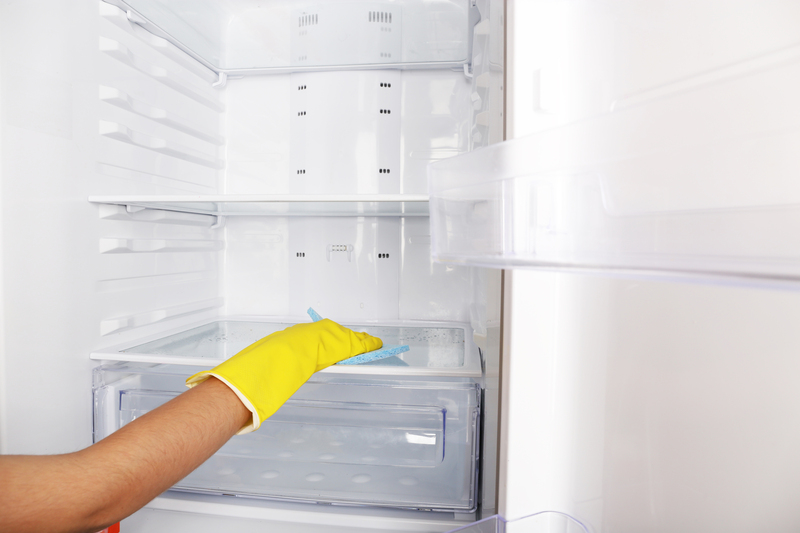Keep Velvet Curtains Pristine: Your Guide to Safe Washing and Maintenance
Posted on 20/09/2025
Keep Velvet Curtains Pristine: Your Guide to Safe Washing and Maintenance
Velvet curtains are the embodiment of elegance and luxury in home decor, bestowing any room with a sophisticated ambiance and a touch of opulence. However, their plush textures and delicate fibers require a specialized care routine to preserve their lustrous appearance. If you are wondering about the best practices for cleaning velvet curtains at home or how to extend the life of these beautiful drapes, this comprehensive guide is designed precisely for you. In this article, we will explore the safe washing, careful maintenance, and smart storage of velvet, ensuring your investment continues to look stunning for years to come.
Why Velvet Curtains Need Special Care
Velvet is a unique textile with a pile formed by evenly cut threads, offering its signature softness and depth of color. This rich texture also makes velvet susceptible to wear, crushing, and water spots, particularly if not handled properly. Because of velvet's delicate nature, standard curtain cleaning methods may do more harm than good.
- Delicate Fibers: Velvet's short, soft pile can be damaged by harsh chemicals or rough handling.
- Water Sensitivity: Moisture can leave unsightly spots or even shrink certain types of velvet.
- Color Retention: Improper cleaning can cause velvet curtains to fade more rapidly than other fabrics.
- Shape Deformation: Over-washing or incorrect drying may permanently distort the elegant drape of velvet curtains.
Understanding these sensitivities is crucial for keeping your velvet curtains pristine and extending their life.

Types of Velvet: Know Your Fabric
Before diving into cleaning techniques, it's important to identify the type of velvet your curtains are made from. Each type responds differently to washing and maintenance:
- Cotton Velvet: Luxurious and soft, but prone to water spots and shrinking. Often needs dry cleaning.
- Silk Velvet: Exquisitely delicate, rarely suitable for water-based cleaning. Requires professional care.
- Synthetic Velvet: Often made from polyester or nylon; generally more forgiving and sometimes safe for home washing.
- Crushed Velvet: Designed for a wrinkled, textured look; can tolerate slightly more robust handling, but care is still needed.
- Velveteen: Shorter pile, more matte finish, and commonly cotton-based. Slightly more durable, but caution is still necessary when cleaning.
Always check the manufacturer's care label on your velvet drapes before attempting any cleaning.
Routine Maintenance: Keep Velvet Curtains Clean Between Washes
Frequent deep cleaning isn't needed for velvet, but regular light maintenance can help prevent dust and dirt build-up:
Vacuuming
- Attach a soft brush: Use the soft brush or upholstery attachment on your vacuum.
- Gentle strokes: Move the nozzle in the direction of the pile to avoid matting.
- Frequency: Vacuum curtains every 2-4 weeks, especially in high-traffic areas or homes with pets.
Brushing
- Use a velvet brush or lint roller: Gently remove dust, lint, and hair without pulling on the fabric.
Dealing with Creases
- Steam, don't iron: Hang the curtain and use a handheld steamer to gently release wrinkles. Hold the steamer at least 10 cm away from the fabric.
- Avoid direct heat: Never use a hot iron directly on velvet, as this will crush the pile and leave marks.
Spot Cleaning Velvet Curtains: Quick Response for Stains
The key to removing stains from velvet curtains is speed and a gentle touch. Here's how to handle most common spills:
Step-by-Step Spot Cleaning Guide
- Blot, don't rub: Use a dry, clean cloth or paper towel to blot as much liquid as possible. Never rub, as it can push the stain deeper or distort the pile.
- Test your solution: For persistent stains, start with a mix of lukewarm water and mild detergent. Always test on an inconspicuous spot first.
- Gently dab: Use a damp, well-wrung cloth to gently blot the stain. Work from the outside in to prevent spreading.
- Remove soap residue: Lightly dab with a clean, damp cloth to eradicate any leftover detergent.
- Dry: Blot with a dry towel, then allow the area to air dry away from direct sunlight or heat.
For persistent or large stains, professional dry cleaning is usually the safest bet for velvet curtains.
Can You Wash Velvet Curtains at Home?
This is one of the most common questions from velvet curtain owners! The answer depends on the fabric type and manufacturing instructions. Let's break it down:
- Cotton & Silk Velvet: Best left to professional dry cleaners.
- Polyester & Some Synthetic Velvets: May be machine or hand-washed with care, if the care label allows.
- Crushed Velvet: Generally more forgiving, but still check instructions.
Hand Washing Velvet Curtains
Follow these careful steps for home washing velvet curtains only if permitted:
- Dust first: Shake gently or use a vacuum with a soft brush to remove loose dirt.
- Fill a bathtub or basin: Use cold or lukewarm water with a small amount of mild, silk-friendly detergent.
- Soak: Immerse curtains for 10-15 minutes--avoid wringing or twisting at any stage.
- Agitate gently: Swish by hand, focusing on particularly soiled areas.
- Rinse thoroughly: Repeat rinsing in clean, cold water until all soap is removed.
- Press water out: Lay out the curtain and gently roll in a thick towel to remove excess water--never wring!
- Hang to dry: Suspend the curtain from the top without folds, away from sunlight and heat. Use padded hangers or a curtain rod to avoid creases or marks.
Machine Washing Velvet Curtains
If your velvet drapes are specifically marked as machine washable:
- Use a front-loading machine or a machine without an agitator to minimize risk of snags.
- Turn curtains inside out and place in a mesh laundry bag (if possible).
- Select a cold water, delicate cycle.
- Use a mild liquid detergent designed for silk or delicate fabrics.
- Remove immediately after cycle to prevent creasing.
Caution: Even with machine-washable synthetic velvet, repeated machine washing can eventually degrade the fabric's plushness and color.
Drying Velvet Curtains: The Safe Way
Drying techniques are just as critical as washing. Velvet's pile can easily be compressed or misshapen by improper drying.
- Never tumble dry: This can ruin the pile and potentially shrink the fabric.
- Reshape while damp: Hang immediately after washing and use your hands to gently arrange pleats and folds.
- Air dry only: Choose a well-ventilated room away from direct sunlight or heaters.
- Brush when dry: Once fully dry, revive the pile by lightly brushing with a soft velvet brush or a clean clothes brush.
Storing Velvet Curtains: Preventing Wrinkles and Fading
Proper storage is essential for maintaining velvet curtains in their original, sumptuous state between seasonal uses or if you're updating your room's decor.
- Clean before storage: Ensure curtains are perfectly dry and clean to prevent mildew or set-in stains.
- Roll, don't fold: If possible, roll curtains onto a tube (such as a cardboard carpet tube) to avoid creasing. If space is limited, fold as loosely as possible.
- Protect from dust and light: Wrap in a cotton sheet or muslin bag; never use plastic, which can trap moisture and cause yellowing.
- Store in a cool, dry area: Avoid basements or attics prone to humidity and temperature fluctuations.
Professional Cleaning: When to Call the Experts
Dry cleaning velvet curtains remains the safest and most effective option for:
- Silk velvet or cotton velvet that's labeled "dry clean only".
- Heavily stained or soiled curtains.
- Antique or sentimental velvet drapes.
- Large sets of curtains that are difficult to handle at home.
Professional cleaners will use specialized solvents and processes to clean velvet curtains without damaging the pile. This method can preserve the richness and elegance of your velvet curtains better than any DIY method.
Tips to Keep Your Velvet Curtains Beautiful
- Minimize sun exposure: Prolonged sunlight can fade even the richest velvet colors. Use lining, blinds, or tiebacks to minimize direct sun.
- Rotate curtains: Occasionally swap curtain panels from left to right or front to back to ensure even wear and sunlight exposure.
- Manage humidity: Use a dehumidifier in damp climates to protect velvet from mildew growth.
- Avoid sprays: Refrain from using air fresheners or cleaning sprays directly on velvet; they can leave permanent marks.
- Handle gently: Always hold velvet curtains with clean hands and avoid pulling or yanking the fabric.

Frequently Asked Questions About Velvet Curtain Care
How often should I clean my velvet curtains?
Dust and vacuum regularly, but deep cleaning (professional or at home) is typically needed only once a year unless there are accidental stains or heavy dust build-up.
Why does my velvet curtain look crushed after washing?
When velvet becomes wet and is not reshaped or dried properly, the pile can flatten and lose its signature plushness. Always air dry, reshape, and brush the pile once dry to revive its texture. For severe crushing, professional cleaning may be needed.
Can I iron velvet curtains?
Never use a hot iron directly on velvet fabric. If needed, use the steam function on your iron at a safe distance or a dedicated garment steamer.
What's the best way to remove dust from velvet drapes?
A soft brush attachment on a vacuum or a velvet brush is ideal for routine dust removal.
When should I call in a professional?
- If your velvet curtains are labeled "dry clean only".
- There are tough stains or odors present.
- The curtains are valuable or antique.
Final Thoughts: Long-Lasting Luxurious Velvet Curtains
Velvet curtains are a true statement piece in any interior, and with the proper care, their elegance can last a lifetime. By following the essential steps for washing, maintaining, and storing velvet curtains safely at home, you'll preserve their iconic richness, color, and plush feel. Remember: when in doubt, refer to your care label, treat velvet with a gentle hand, and never underestimate the value of professional cleaning for long-term beauty.
Keep your velvet curtains pristine, and enjoy the luxury and warmth they bring to your home year after year!





